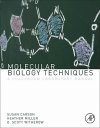Textbook Handbook / Manual
By: Sue Carson(Author), Heather Miller(Author), D Scott Witherow(Author)
232 pages, illustrations
![Molecular Biology Techniques Molecular Biology Techniques]()
Click to have a closer look
About this book
Contents
Customer reviews
Related titles
About this book
Molecular Biology Techniques is an indispensable tool for introducing advanced undergraduates and beginning graduate students to the techniques of recombinant DNA technology, or gene cloning and expression. The techniques used in basic research and biotechnology laboratories are covered in detail. Students gain hands-on experience from start to finish in subcloning a gene into an expression vector, through purification of the recombinant protein.
The third edition has been completely re-written, with new laboratory exercises and all new illustrations and text, designed for a typical 15-week semester, rather than a 4-week intensive course. The "project" approach to experiments was maintained: students still follow a cloning project through to completion, culminating in the purification of recombinant protein. It takes advantage of the enhanced green fluorescent protein – students can actually visualize positive clones following IPTG induction.
Contents
Preface
About the Authors
Acknowledgements
Note to Instructors
Instrumentation
Nomenclature
Introduction
Part 1. Manipulation of DNA
Lab Session 1. Getting Oriented
Lab Session 2. Purification and Digestion of Plasmid (Vector) DNA
Lab Session 3. PCR Amplification of egfp and Completion of Vector Preparation
Lab Session 4. Preparation of Insert DNA (egfp) PCR Product
Lab Session 5. DNA Ligation and Transformation of Escherichia coli
Part 2. Screening Transformants
Lab Session 6. Colony Hybridization
Lab Session 6A. Interim Laboratory Session
Lab Session 6B. Colony Hybridization: Monoclonal Antibody Probe
Lab Session 7. Characterization of Recombinant Clones
Lab Session 7A. Completion of Colony Hybridization with a Monoclonal Antibody Probe
Lab Session 7B. PCR Screening
Lab Session 7C. Prepare Fresh Replica Plate
Lab Session 8. Characterization of Recombinant Clones
Lab Session 8A. Interim Laboratory Session
Lab Session 8B. Analysis of PCR Screen Results
Lab Session 8C. Isolation of Miniprep DNA from Potential Transformants
Lab Session 8D. Visualization of Green Fluorescent Protein: Part 1
Lab Session 9. Characterization of Recombinant Clones
Lab Session 9A. Characterization of Miniprep DNA from Potential Transformants (Restriction Enzyme Analysis of Putative Transformants)
Lab Session 9B. Visualization of Green Fluorescent Protein: Part 2
Lab Session 9C. Computational Analysis of DNA Sequence from a Positive Clone: Part 1
Lab Session 10. Computational Analysis of DNA Sequence from a Positive Clone
Part 3. Expression, Detection and Purification of Recombinant Proteins from Bacteria
Lab Session 11. Expression of Fusion Protein from Positive Clones, SDS-PAGE and Western Blot
Lab Session 11A. Interim Laboratory Session
Lab Session 11B. Expression of Fusion Protein from Positive Clones, SDS-PAGE and Western Blot
Lab Session 12. Expression of Fusion Protein from Positive Clones, SDS-PAGE and Western Blot
Lab Session 13. Extraction of Recombinant Protein from Escherichia coli Using a Glutathione Affinity Column
Lab Session 13A. Interim Laboratory Session
Lab Session 13B. Extraction of Recombinant Protein from Escherichia coli and Purification Using a Glutathione Affinity Column
Lab Session 14. Analysis of Purification Fractions
Lab Session 14A. Analysis of Purification Fractions
Lab Session 14B. Replica Plate Positive Clone
Part 4. Analysis of mRNA Levels
Lab Session 15. Total RNA Purification
Lab Session 15A. Interim Laboratory Session
Lab Session 15B. Total RNA Purification
Lab Session 16. Analysis of gst::egfp mRNA Levels by RT-qPCR
Lab Session 17. Analysis of gst::egfp mRNA Levels by RT-qPCR
Lab Session 18. Analysis of gst::egfp mRNA Levels by Semi-Quantitative RT-PCR
Lab Session 19. Analysis of gst::egfp mRNA Levels by Semi-Quantitative RT-PCR
Appendix 1. Equipment
Appendix 2. Prep List
Appendix 3. Preparation of Competent E. coli Cells
Appendix 4. Pre-Lab Questions
Customer Reviews
Textbook Handbook / Manual
By: Sue Carson(Author), Heather Miller(Author), D Scott Witherow(Author)
232 pages, illustrations



































